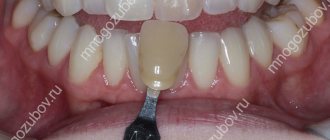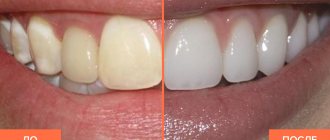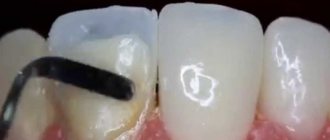Veneers are thin overlays, mainly made of ceramics, that are installed on the front surface of the tooth and the cutting edge. They are used to correct irregular shapes, hide chips and cracks, and eliminate excess gaps. But the most common reason why patients decide to have these miniature dentures installed is the desire to give their teeth a lighter and more even shade. Chemical whitening does not always give the desired effect and requires regular repetition, but veneers solve aesthetic problems comprehensively and for a long time.
How is the color of veneers determined?
To select the color of ceramic microprostheses, dentists use a special scale called Vita. It includes:
- 16 natural shades;
- 4 ultra-whites that practically do not exist in nature - Bleach.
Thus, you can choose the appropriate color from as many as 20 options. If the patient only needs a few restorations, the shade of the veneers should match the color of the adjacent teeth. However, if microprostheses are placed over the entire smile area, then the patient is free to choose any color he likes, based on his ideas about beauty and the doctor’s recommendations.
Naturally colored veneers according to the Vita scale are presented in the form of four blocks in accordance with the enamel undertone:
- A - red-brown;
- B - yellow-red;
- C - gray;
- D - gray-red.
There is no need to be alarmed: such a classification does not mean that the selected sample will be red or gray. Only a specialist will see the difference between the tone of ceramic veneers; for patients, they look approximately the same - like ordinary natural teeth.
Each of the four blocks contains four shades, grouped by brightness: from the lightest to the darkest. They are designated by the numbers 1, 2, 3 and 4. Accordingly, all tooth colors on the Vita scale have their own alphabetic and digital number - for example, a2 or b1.
How to choose a color?
If the patient is going to choose the tone on his own, take into account the conditions that affect the visual component:
- Skin tones. The darker the skin, the whiter the teeth look.
- Hair. Like with skin. Brunettes have a brighter smile than blondes.
- Whites of the eyes. If they are dimmer than the smile area, it looks unnatural and stands out too much when opening the mouth.
- The material from which the dental structure is made. Plastic materials differ from metal ceramics, even with the same index on the Vita scale.
Changes in lighting and dimming distort the perception of colors. The walls in the clinic and the clothes of the dentist and patient should be of a neutral shade. Women are advised to remove lipstick. Sometimes the rest of the cosmetics are removed.
The most popular colors of ceramic veneers
The standard for a beautiful smile is straight, light teeth that look natural. Aesthetic dentistry helps to achieve exactly this effect, so it is not surprising that the most popular shades on the Vita scale are considered to be the first numbers in tones A and B.
✔
Patients who want natural veneers are most often attracted to color a1 (photo). This is a light pearl shade, close in brightness to the Bleach range, but without artificial whiteness. This color is refreshing and, without exaggeration, rejuvenating, because, as we know, in our youth our teeth look much whiter.
✔
The color of A2 teeth is a little darker, but only a doctor can distinguish such veneers from natural teeth - those around you will be sure that your smile is so naturally beautiful.
✔
Another favorite tooth color for many is b1. It's just as light and bright as a1, but has a different tonality that will be preferable for certain skin tones.
Natural color
The main factor determining the natural color of teeth is heredity. Individual saturation and shade are determined by yellowish dentin, visible through the translucent enamel. At the same time, the natural color is heterogeneous - it changes from the cervical region (where it is more yellow due to the thick layer of dentin) to the almost transparent, and because of this, seemingly grayish cutting edge. The curvature of the tooth surface and the thickness of the enamel play a certain role. The enamel itself is transparent, but the thicker its layer, the more it refracts light.
In addition, the shade changes with age. The enamel becomes thinner and loses transparency. The color of the dentin also changes - it becomes darker. Because of this, the smile darkens with age.
Teeth can change color when exposed to brightly colored drinks or foods, or tobacco. But such a change is to some extent reversible thanks to whitening procedures . But depulpation, as well as discoloration (redness) as a result of taking potent drugs (for example, some antibiotics), unfortunately, changes the natural color of the teeth irrevocably, so they have to be restored with the help of veneers or crowns.
Bleach teeth color - Hollywood smile
No matter how much natural beauty is valued, many patients dream of a dazzling white smile, like that of movie stars. For such cases, the Vita palette includes four snow-white shades “Bleach”, which do not exist in nature.
Bleach 1 and Bleach 2 are bright white enamel with virtually no yellow pigment. Such shades are associated with shockingness and can only look good on stage, in the spotlight and against the backdrop of bright makeup. In shades Bleach 3 and Bleach 4 a small percentage of yellow pigment appears, but they still remain outside the natural palette.
The bleach color of ceramic veneers looks more appropriate on dark skin. Those with Northern European appearance are better off giving preference to natural shades a1 and b1 - they are just as light, but look more organic.
How does a dentist determine the color of teeth?
It is known that color is very dependent on lighting. For example, artificial lighting gives objects a coldish tint, while natural lighting, on the contrary, paints everything in warm tones. Therefore, professional guidelines recommend assessing the color of teeth in natural diffused light, which comes from the north side between 10 and 12:00 am [4]. This is the lighting that is accepted as standard. Of course, in a dentist’s office it is impossible to always comply with such conditions, so the selection of the shade of dentures is made under the illumination of special fluorescent lamps that produce light of a certain intensity and color temperature.
To avoid distortions in color perception, it is recommended to cover the patient with a neutral-colored cape, and also not to use bright decorative elements in the office where the reception is taking place.
Before choosing the shade of a denture or composite for a filling, the dentist performs a professional cleaning to remove dental deposits. After this, it is recommended to moisten the enamel surface or not to overdry it.
“When selecting a color, we start by giving the VITA shade and a mirror to the patient, and he “plays doctor” for 5 minutes (as a rule, he chooses a lighter color than necessary), and then my assistant and I get involved.”
Chilikin V.N., Honored Doctor of the Russian Federation, Doctor of Medical Sciences, Professor of the Department of Hospital Therapeutic and Geriatric Dentistry of Moscow State Medical University, Deputy Chairman of the Endodontics Section of the Russian Dental Association, Member of the International Endodontic Federation of the European Endodontic Society [4]
The doctor one by one brings samples to the patient’s teeth, selecting the color. In this case, the specialist must be at a sufficient distance (at least 50 cm) so as not to block the lighting. First, a group is selected, then the shade is determined. It is recommended to examine teeth and samples from different angles - this will reduce the likelihood of error.
List of sources
- Pogosyan N. G. Technical aspects of determining the color of teeth in the clinic of orthopedic dentistry // Symbol of Science. 2016. No. 8-1. URL: https://cyberleninka.ru/article/n/tehnicheskie-aspekty-opredeleniya-tsveta-zubov-v-klinike-ortopedicheskoy-stomatologii (date of access: 08/03/2020).
- Plaka L. Psychology of color perception // National Pharmaceutical University of Ukraine. URL: https://nuph.edu.ua/ru/psihologiya-vospriyatiya-cveta/ (date accessed 09/03/2020).
- Karachausheva V. A. Methods for determining the color of teeth in dentistry // BMIK. 2015. No. 10. — URL: https://cyberleninka.ru/article/n/sposoby-opredeleniya-tsveta-zubov-v-stomatologii (date of access: 08/03/2020).
- Chilikin V.N. The latest technologies in aesthetic dentistry. M.: State Unitary Enterprise NIKIET. 2001. URL: https://03book.ru/upload/iblock/801/257_Novejshie_tehnologii_v_jesteticheskoj_stomatologiidChilikinb.pdf (date of access: 08/03/2020)
Colors of Emax ceramic veneers
Emax glass-ceramic microprostheses differ from conventional ceramic veneers in their manufacturing technology. Accordingly, for overlays of this type there is a separate color scale - Vita 3D-Master. Here, not two, but three color selection options are used.
- Brightness - from 1 to 5.
- The tonality is L (more yellow) and R (more red).
- Saturation - from M1 to M3.
To determine the shade of the future veneer, the doctor first determines its brightness, moving from the darkest to the lightest, then selects the intensity level M and, lastly, the tonality L or R. The color codes of the Vita 3D-Master palette consist of three symbols - for example, 3M2 .
Composite veneer colors
Unlike ceramic onlays, the shades of which are standardized on a scale, composite veneers of the same color, but made from materials from different manufacturers, may differ from each other. This nuance significantly complicates restoration in the event of a chip, when the doctor may not have the material of the required company at hand.
The colors of composite veneers are also not as varied as ceramic ones. If the palette for ceramic onlays includes 20 values, then the composite is usually limited to six options. This is A1-A4, a matte (opaque) material that imitates tooth dentin and is transparent for cutting edges. Therefore, it is more difficult to obtain natural-looking veneers from a composite that will not differ from natural teeth.
When installing photopolymer overlays, it is worth taking into account their tendency to fade and yellow. Initially, before modeling, it is better to choose a shade half a tone lighter than the rest of the teeth , so that after the pigments are absorbed by the material, its color will match the rest of the teeth. Taking into account the listed nuances, composite overlays are used more as temporary veneers, and after 1-3 years they are replaced with ceramic ones.
What color of veneers should I choose?
A doctor will help you find the right shade for your restorations, ideally together with a dental technician.
If it is necessary to restore the aesthetics of individual teeth, the color of the onlays is selected in accordance with the shade of the “neighbors”. Before getting veneers, you may be recommended a whitening procedure to make your teeth 1-2 shades whiter and choose lighter veneers. Using a palette, the doctor determines the color of each restoration separately, since the central incisors, lateral incisors and canines naturally have different colors and degrees of brightness.
If we are talking about installing veneers on all teeth, then certain rules apply for choosing a shade.
Bleach colored veneers
This is the name given to the whitest veneers, which amaze with their dazzling shine. The color of Bleach veneers has not gone out of fashion among celebrities for many years, even though it sometimes looks too unnatural. Many compare it with ceramic sanitary ware, and for the average person, especially those with a serious profession (lawyer, teacher, politician), the Bleach color is not the best choice.
Against the background of the overall glamorous appearance and concert make-up, snow-white teeth look bright, catch the eye and stand out from the crowd. Against the background of ordinary everyday clothes, the color of Bleach veneers will look simply ridiculous.
The shade should be selected according to the principle: the darker the skin and hair, the lighter the teeth should be . Those. a dark-skinned person with dark hair and eyes can easily choose bl 3 or bl 4, and it will look more or less organic. For most Europeans, a more acceptable option is pearl shade A1, A2, etc. You shouldn’t chase Instagram trends in vain, so that in a few years, when unnatural whiteness goes out of fashion, the design doesn’t have to be changed.
Emax veneer colors
Unlike classic ceramic onlays for Emax veneers, colors are selected not according to the classic Vita scale, but according to the Vita 3D-Master. This palette is distinguished by taking into account not two, but three colorimetric parameters :
- tones: L - yellow tint, R - red tint;
- intensity (saturation): in the range M1-M3;
- brightness in the range of values 1-5.
The 3D-Master scale contains 26 values compared to the classic Vitapan palette of 20 positions. This variety allows you to reproduce the colors of Emax veneers as close to natural as possible and win positive reviews from their owners.
To create each veneer for a tooth, the color is determined in three zones: cervical, main and along the incisal edge. So, the middle part of the crown can have b1, and the area of the tooth neck can be color 2. According to the 3D-Master scale, which also takes into account the depth of transparency, the cutting edge of the crown is, as a rule, more transparent than the rest. For example, veneers of color 3 along the incisal edge will have a lower intensity in the palette (1 or 2).
Since the color of ceramic overlays does not change over time, it is important to choose it correctly from the beginning. To do this, at the fitting stage, if the work looks too bright, the overlays are sent back to the laboratory for correction. As a result, the design should look so that even upon close examination it would be difficult to distinguish between artificial veneers and natural teeth.
How to choose a color in preparation for prosthetics?
Before installing the structures, the dentist and the patient select the desired color. If the replacement concerns a section of the dentition or single fragments, the choice is obvious. They are made identical in color to adjacent teeth. If you plan to install veneers or crowns on all teeth in the smile area, their color is selected separately at the request of the patient and the advice of the doctor. The choice is influenced by the following factors:
- color of the skin;
- hair color;
- shade of the whites of the eyes;
- the material from which the structure is made.
Your attending physician will tell you more about the last point. The fact is that the same color index looks different for different materials.
The choice of color occurs in natural daylight. When choosing a shade for a woman, it is better to cleanse the skin of foundation and wipe off lipstick. It is better to choose a color when the skin is not tanned.
The color of your smile will stay with you forever. Contact a clinic where there are conditions for selecting a shade, modern materials are used and professionals in this field of dentistry work.
Features of choosing a shade
Before deciding to install veneers, it is recommended to consult a dentist and conduct a comparative analysis using the Vita table. The sample produced by Ivoclar Vivadent is widely popular.
The palette consists of light natural shades. As an alternative, computer technology can be used, which also allows you to select the appropriate shade.
It is worth noting that the most accurate result is achieved through a visual comparison.
Reference! When determining the shade of a tooth, three areas with different tones are taken into account:
- neck of the tooth;
- central part of the crown;
- cutting surface.
Modern dental offices are equipped with special lighting units with adjustable brightness, which allows creating suitable conditions for assessing the shade of enamel. Most dental offices have muted interiors, as bright accents can distort the quality of visualization. In addition, the office should have an atmosphere that is comfortable for the patient.
Ceramic veneers are considered the most preferable, since ceramics are as close as possible to the natural surface of the tooth, both in appearance and in characteristics.
Additional recommendations
In order for the installed veneers to look aesthetically pleasing against the background of other teeth, it is recommended to take note of the following:
- Select the color of the aesthetic prosthesis taking into account the color of the eyes and eye whites.
- Take into account skin tone, in particular the degree of melanin, and also take into account hair color. Against a tan background, your teeth will look more contrasting.
- People of the Slavic type are better off choosing veneers in natural shades.
- You need to choose the shade of the overlay without first applying makeup. In addition, it is recommended to go to the dental clinic in clothes of calm shades, since bright accessories and colors can distort color perception.
- The day before going to the dentist, you should avoid tooth enamel whitening procedures and avoid drinking soda drinks and foods with food coloring.
Important! Finished composite and porcelain veneers with the same Vita designation may look different after installation. This is an important aspect that should not be overlooked when choosing a material.











